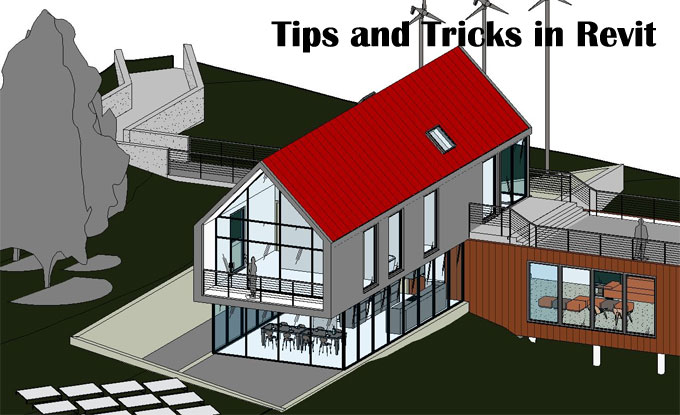Top 40 Revit Tips to Live On
Tweet
Autodesk Revit is arguably the best BIM (Building Information Modeling) tool around the world. This champion software has it all for designing construction engineering models and preparing constructible documents. But to utilize Revit fully, you need to know all the nooks and crannies in the software. And to help with that, here are the top 40 revit tips to live on!
Top 40 Revit Tips & Best Practices
1. This may sound cheesy, but? don't go back to AutoCAD! Ever.
2. Periodically set the walls transparent to see what's behind them.
3. Best if you don't make a large group at one. Try building a small group and add elements to it.
4. Don't import stuff until you really need them, because they burden a model.
5. Don't annotate 3D elements as 2D - keep it proper, especially in case of openings.
6. Smart family, smart choice!
7. Link your schedules to excel files, so you can make changes easily across the board.
8. When you're working with a pretty heavy model, try not to use the filter option for viewing selective stuff - it's messy. Rather use the Visibility > Graphics > select necessary ones.
9. Get a good mouse. For your computer, not for your cat. This is your real tool you will be physically handling all day, so be serious about it. It's a great idea to get one with very high DPI settings and multiple programmable buttons, so you can assign shortcuts to those buttons.
10. Don't be afraid to ask for help. The online community is full of froods happy to help out a fellow frood.
11. Revit allows few mistakes that you can just undo and forget. This isn't AutoCAD. Draw responsibly.
12. Working on a black background is a VERY BAD IDEA for Revit. Doesn't matter if that's your style or mood or groove or whatever. Keep it clean and reduce the screen brightness.
13. Get a good graphics card. Revit is a hungry hungry software and you need the video muscles to lift it.
14. In line with the above, remember: GeForce cards > Quadro cards > Radeon cards. Don't get fooled by ads.
15. Try not to place an element directly in its place - try placing it on the side somewhere and then move it where it is needed.
16. Sometimes Revit gets smarter than you and does stuff automatically that you never intended. In that case, cheat. Shamelessly.
17. Adjust settings to hide details at larger scales, to prevent detail tags from showing up on overall plans, elevations, sections etc.
18. Some features are limited by intention. Don't get mad at them - this is intentionally done to make you go the longer way instead of taking dangerous shortcuts. Respect these limitations.
19. Don't copy-paste families into other drawings. It may be the faster way but it is not clean and prone to mistakes. Use the Load Family option.
20. Tip for beginners: There are plenty of templates in the Autodesk Community, and they are great to start off with.
21. If you have to do things repetitively in your work often, maybe it is worth learning Dynamo and automating your work?
22. Customize your floor plan well instead of opening photoshop.
23. When you need to import high resolution images, collect them into a separate RVT file to lessen the load on your model file.
24. Don't keep rendered images in your project file! These expendable files take up valuable space. Export them to disk instead.
25. Learn to use the 3D View Borders tool to your advantage when making presentations of each level.
26. Revit is still not error free. Expect crashes, and so, save often.
27. If a command freezes up the system, you can try pressing the escape button quite a few times and get rewarded with a 'Stop operation' dialog box, instead of restarting.
28. Clean up your levels! Discard those that you don't need anymore.
29. If you're going to work in one area only for quite some time, it's a great idea to zoom in there. This will reduce display operations.
30. Try to avoid making 3D furniture. If you have to, place them separately in other files.
31. Try making 2D furniture instead of 3D. After all, Revit is for architecture, not interior decoration.
32. Working on multiple screens? Stretch the Revit window Across both screens by dragging the border!
33. Tricky element, always running away> Pin it down!
34. The F8 button is your great friend, giving you the last view again and again when you get blindsided.
35. Taking a break? Restart Revit before you go - this will clear up the junk from the cache.
36. Learn keyboard shortcuts by hundreds and recite them at bedtime. Revit will literally be at your fingertips.
37. Drag-copy is a thing!
38. Don't do volume calculations until they are required (for exports or otherwise).
39. Naming your reference planes is a good idea since that allows you to later select them as work planes to draw on.
40. Arrow keys move objects. Hold shift to move faster.
Wrapping Up
We hope the above top 40 Revit tips and tricks were useful to you! This article is intended for Revit beginners who aspire to get to the pro level quickly. And for the pros - if you know more such Revit tips and tricks, please use the comment box below to share your wisdom to the crowd!

Gallery
Feel free to contact us for BIM requirements. One of our representative will respond you within 24 Hours. Send us your projects requirement today and grow your project.
Explore More !







